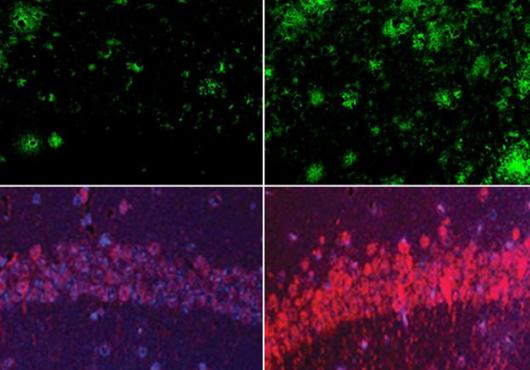
New research led by Harvard Medical School scientists at Massachusetts Eye and Ear and Brigham and Women’s Hospital reveals the role that a genetic variant associated with Alzheimer’s disease, APOE4, plays in protecting against glaucoma.
In the new study, published Aug. 16 in Immunity, the researchers also used a pharmacologic treatment to successfully prevent the destruction of neurons in the eyes of mice with glaucoma by targeting the APOE (apolipoprotein E) signaling pathway.
Specifically, the scientists demonstrated that the APOE4 gene variant, which increases risk for Alzheimer’s but decreases risk for glaucoma in humans, blocks a disease cascade that leads to the destruction of retinal ganglion cells in glaucoma.
Additionally, they showed in separate mouse models that the death of retinal ganglion cells — the cause of vision loss in glaucoma — can be prevented by using medications to inhibit a molecule called Galectin-3, which is regulated by the APOE gene.
These findings taken together emphasize the critical role of APOE in glaucoma and suggest that Galectin-3 inhibitors hold promise as a glaucoma treatment, according to the authors.
“Our research provides greater understanding of the genetic pathway that leads to irreversible blindness in glaucoma, and importantly, points to a possible treatment to address the root cause of the vision loss,” said lead study author Milica Margeta, HMS assistant professor of ophthalmology and a glaucoma specialist and scientist at Mass Eye and Ear.
“This study shows that the APOE-mediated disease cascade is clearly harmful in glaucoma, and that when you interfere with it genetically or pharmacologically, you can actually stop the disease.”
Understanding, halting the cause of vision loss in glaucoma
Glaucoma is a leading cause of blindness, affecting an estimated 80 million people worldwide. Despite how common the disease is, little is known about the underlying mechanisms that lead to the loss of retinal ganglion cells, which ultimately results in vision loss.
Accordingly, there is no treatment to directly promote survival of these cells; current treatments, including medications, laser therapies, and surgeries are aimed at lowering eye pressure, the only modifiable risk factor for glaucoma.
However, the disease often progresses despite these interventions and can result in complete blindness.
Scientists have suspected that glaucoma may be the result of a microscopic inflammatory process in the eyes.
Previous studies by this research team and others showed that this inflammatory process occurs in the optic nerve of glaucoma patients, as indicated by the presence of activated microglia, cells that act as first-line immune responders in the eye and brain.
Microglia can be beneficial in healthy tissue; however, in eye diseases and neurodegenerative conditions like Alzheimer’s and Parkinson’s, microglia can produce toxic molecules, destroy living neurons, and make neighboring cells become inflammatory.
A seminal 2017 study led by principal investigator Oleg Butovsky, HMS associate professor of neurology at Brigham and Women’s, found that in neurodegenerative diseases, including Alzheimer’s, amyotrophic lateral sclerosis (ALS), and multiple sclerosis, microglia switch to a microglial neurodegenerative phenotype (MGnD), mediated by the APOE gene.
It is well established in neurological research that one variant of this gene, APOE4, is linked to an increased risk for late-onset Alzheimer’s disease.
Interestingly, an earlier study led by Margeta found APOE4 is associated with a decreased risk of developing glaucoma, but it was not understood why.
The new study led by Margeta and Butovsky sheds light on this mechanism. The scientists used RNA sequencing to provide an unbiased look at which genes were turned on and off in microglia in different mouse models with glaucoma.
They identified a disease cascade in which APOE controls the microglial transition from a healthy cell to a toxic neurodegenerative cell by regulating another molecule called Galectin-3.
When researchers attempted to induce glaucoma in a mouse with the APOE4 variant, they found that, despite the expected elevated eye pressure, the microglia were unable to turn on this toxic cascade and did not produce Galectin-3, instead remaining in a homeostatic state with preservation of retinal ganglion cells.
The same findings were observed in mice without APOE: the toxic signaling cascade was not turned on, Galectin-3 was not produced, and neurons were protected.
The scientists also analyzed human eye tissue samples provided by Duke University Medical Center and confirmed that Galectin-3 was increased in the retinas of glaucoma patients with the common APOE3 variant but was almost undetectable in patients with the APOE4variant.
“This was a striking finding and led to testing whether a pharmacologic intervention could block Galectin-3, which could potentially treat glaucoma,” explained senior study author Butovsky.
The scientists used Galactin-3 inhibitors, which can be derived from natural sources and are currently in clinical trials for the lung disease pulmonary fibrosis.
They found that injecting these inhibitors inside the eye blocked the disease cascade in mice with glaucoma, and the retinal ganglion cells were protected despite elevated eye pressure.
“Our findings provide an explanation as to why APOE4 is associated with a decreased risk of glaucoma and show that the APOE signaling pathway is a promising target for neuroprotective treatments for this blinding disease. However, why the same allele is deleterious in Alzheimer’s disease but protective in eye neurodegenerative diseases has yet to be addressed,” said Butovsky.
Paving the way for clinical trials
This study is the first to examine the role of Galectin-3 in the development of glaucoma and to show the value of inhibiting this molecule in order to prevent retinal ganglion cell death.
Future studies by this research team will look more closely at Galectin-3 inhibitors as treatments for glaucoma, testing them in additional animal models as well as looking at more minimally invasive approaches to inhibitor delivery, such as oral administration or in a slow-release gel.
Ongoing studies are also examining eye fluid and serum samples collected from patients during glaucoma surgery to better understand the patient population in which Galectin-3 inhibition would be a potential therapeutic approach.
For example, patients could be candidates for treatment with inhibitor medication if Galectin-3 is found to be elevated in their biofluids. Such studies can pave the way to translate this research into human clinical trials, according to the authors.
“Glaucoma remains a blinding disease for millions of people around the world, and these exciting findings by doctors Margeta and Butovsky and team provide insight into the role of genetic variants and the promise of translation to a treatment for patients,” said Joan Miller, the David Glendenning Cogan Professor of Ophthalmology and chair of ophthalmology at HMS and chief of ophthalmology at Mass Eye and Ear, Massachusetts General Hospital, and Brigham and Women’s.
Butovsky and his lab are conducting research examining the APOE microglial cascade and the role of the APOE4 variant in microglial regulation in Alzheimer’s disease.
Co-authors on the study included Zhuoran Yin, Charlotte Madore, Kristen M. Pitts, Sophia M. Letcher, Jing Tang, Shuhong Jiang, Christian D. Gauthier, Sebastian R. Silveira, Caitlin M. Schroeder, Eleonora M. Lad, Alan D. Proia, Rudolph E. Tanzi, David M. Holtzman, Susanne Krasemann, and Dong Feng Chen.
This study was funded by the Cure Alzheimer’s Fund, National Eye Institute, National Institute of Neurological Disorders and Stroke, BrightFocus Foundation, American Glaucoma Society Young Clinician Scientist Award, and Research to Prevent Blindness Career Development Award.





